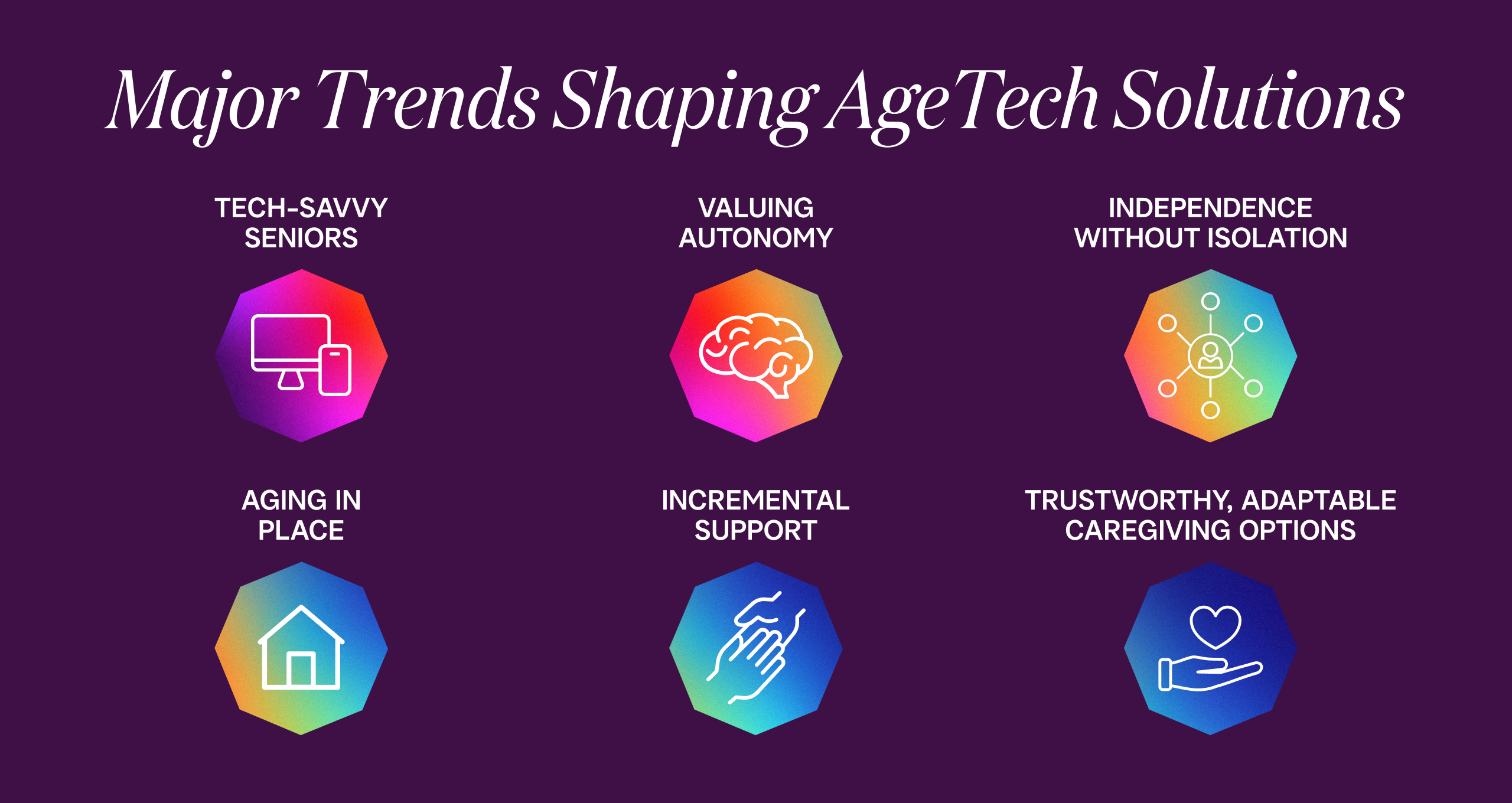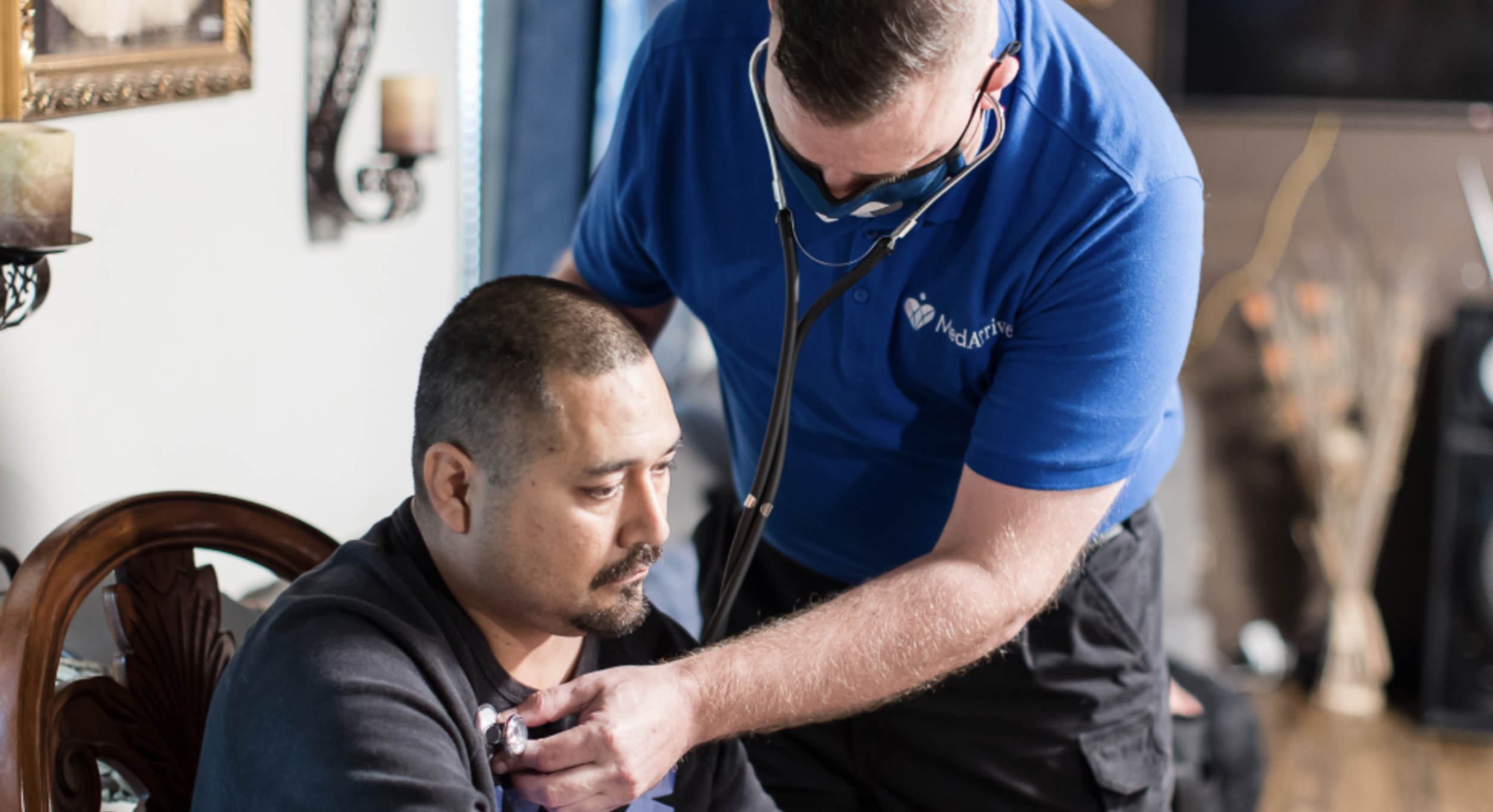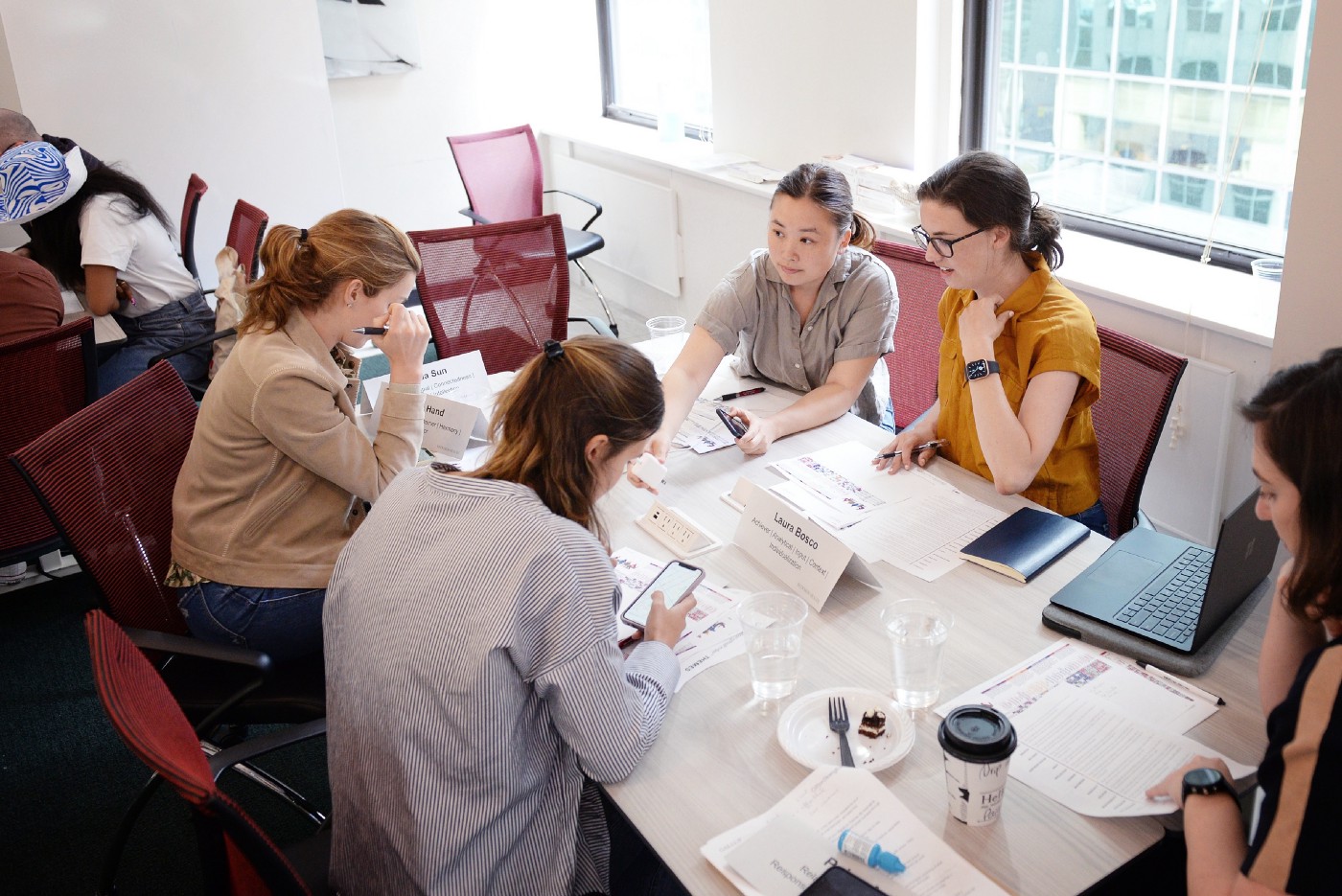
Stuck in the Middle: Healthcare Solutions for Older Adults Shouldn’t Be One Size Fits All. Here's Why.
As part of Redesign Health’s iterative approach to company building, our Venture Insights Team develops and conducts original research via varying methodologies to gain in-depth understanding of prospective buyer and user experiences, unmet needs, and motivations; inform MVP product features and design; and, size market opportunities and ideal targets. These insights feed business innovation and strategic decision making across ideation, development, and launch.
For the first time in history, there will be more older adults than children in America by 2035. We are not ready. According to the U.S. Census Bureau, this aging population could lead to greater demands on the healthcare industry, as well as an increased need for in-home caregiving and assisted living facilities. A one-size-fits-all approach to older adult healthcare simply won’t be able to comprehensively support the needs of so many aging people, as there are many nuances within this segment.
By redesigning the approach to healthcare solutions aimed at older adults, and ensuring these solutions meet their actual needs, we can promote earlier adoption of technologies that help contribute to healthier aging. The more adherent and accustomed older adults are to healthcare solutions now, the greater our ability to proactively impact the health of an entire generation – one of historically significant size – as they age into their later years. By understanding older adults’ passions and desires, along with what motivates this demographic, we can better design health solutions to meet every need so they'll be more likely to fully engage with these services and solutions as they grow older.
Our research team has spent a significant amount of time exploring this population’s needs, opportunities and challenges in order to identify potential solutions to support the creation of five Operating Companies built at Redesign Health. This included a mixed methodologies approach of both quantitative and qualitative research across nearly 7,000 seniors over three years. One of the key learnings across the board is that a one-size-all approach does not apply to a demographic that spans 30+ years. We’ve identified that the younger population, those between the ages of 65 and 75, have their own distinct preferences and motivators. We refer to this group as “the Middlers.”
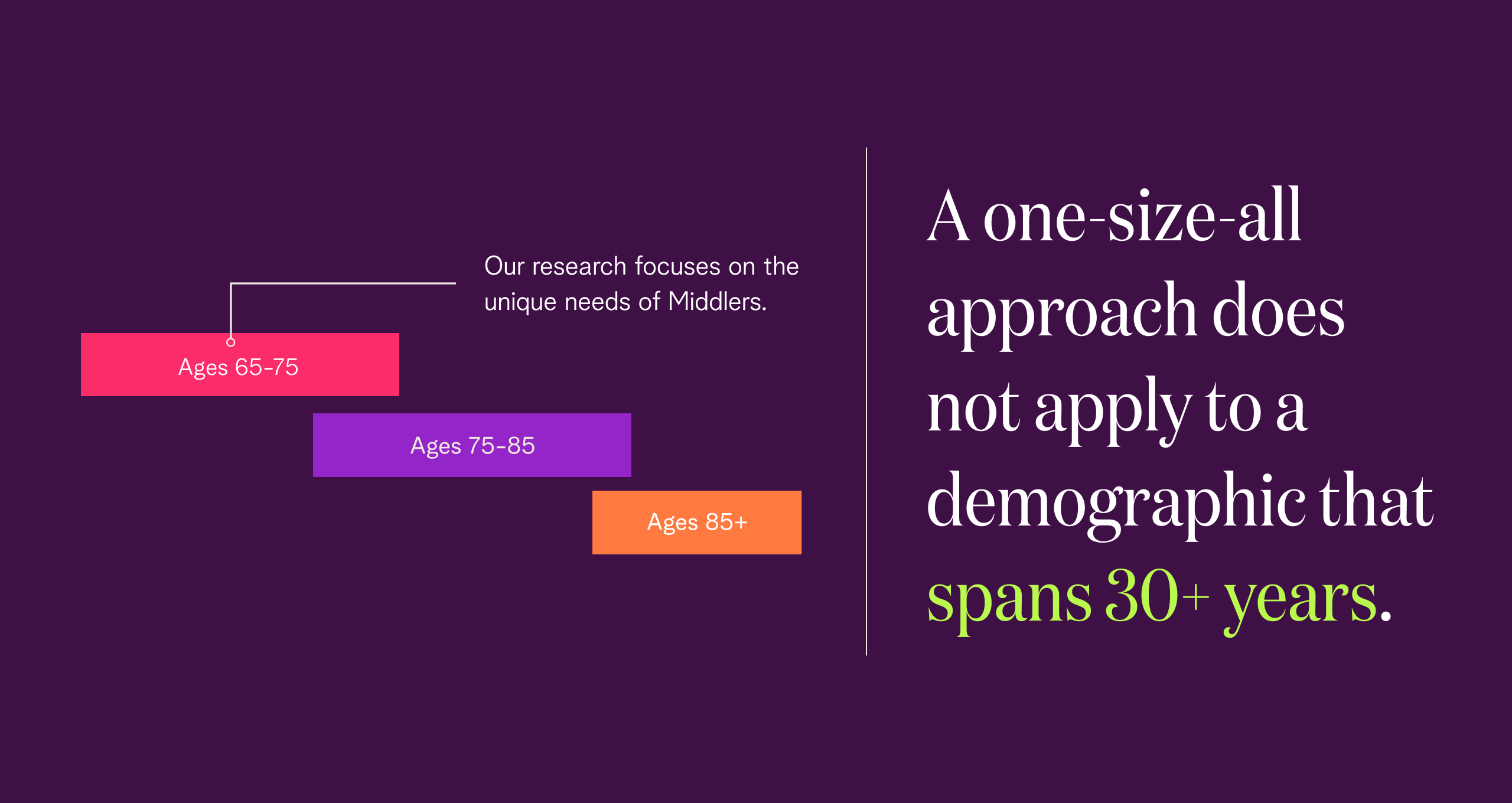
The range of our research captures insights from people aging into, through, and out of the Middlers demographic. Out of this work, a pattern has emerged. Healthcare innovation and solutions routinely put everyone above the age of 65+ in the same bucket. When the needs and desires of 60 year olds are lumped together with those who are 90 and above (how many times have you seen discounts focused on those 65+?), Middlers end up lacking healthcare solutions tailored to the reality of their day-to-day living.
While nearly 100% of Middlers list staying healthy as a primary focus, they often feel misrepresented by healthcare solutions and advertisements that evoke an outdated vision of what it means to grow older. In fact, nearly half (44%) aged 60-79 agree with the sentiment: “I do not identify with ads targeted at older adults” and nearly one quarter (24%) agree that they “feel more connected to brands and advertising geared towards younger generations.” This indicates a significant gap in the solutions being built and marketed towards this demographic. Additionally, 78% of Middlers we surveyed also indicated that they “enjoy learning new things or technologies” — a stereotype that is not typically associated with the broad brush strokes of the general older adult population.
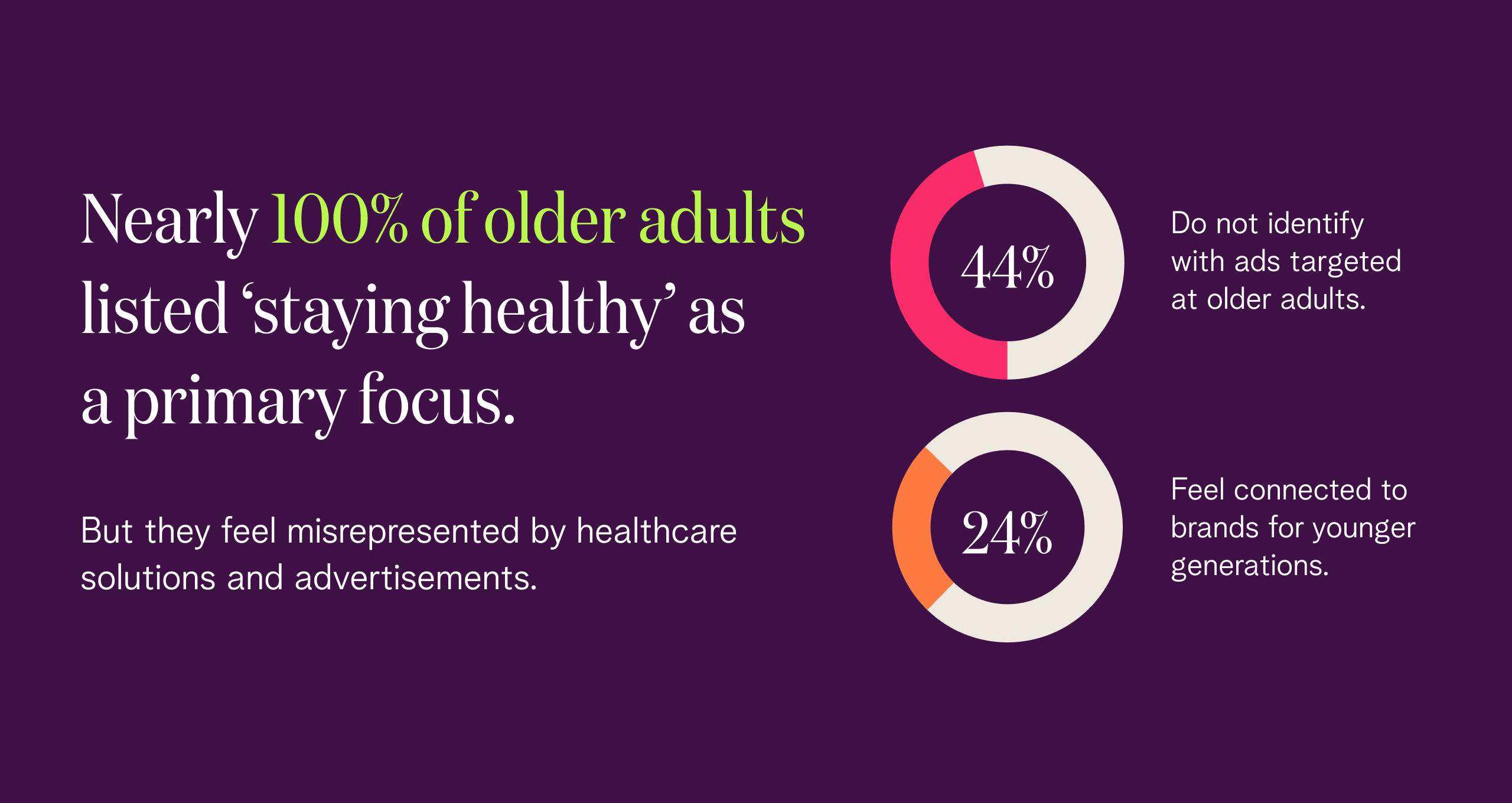
The Middlers are a group of people who value independence, are focused on living life to the fullest, and notice when companies assume otherwise. While their lives and health needs might be changing, their worlds are continuing to expand. These life-long learners are more than capable of enjoying the aid of digital healthcare solutions. Middlers need a suite of healthcare solutions that recognizes and capitalizes on their strong points. More than that, they deserve to be as proactively engaged in their healthcare as they are in every other area of their lives.
We believe there’s extensive opportunity to build comprehensive healthcare solutions at scale for Middlers. That process starts with getting on the same page about what Middlers need and expect from their healthcare solutions.
Middlers value independence and personal fulfillment: healthcare solutions need to deliver both.
Middlers needs are unique. Health solutions are top-of-mind for this group and must be redesigned to fit their reality better. As mentioned above, nearly half (44%) agree with the sentiment: “I do not identify with ads targeted at older adults.” Our research paints a clear portrait of an aging generation focused on finding fulfillment and purpose. In fact, this is a group that is eager to invest in themselves during what one survey respondent called “the age of me.”
Over one-third (34%) of the Middlers surveyed said enjoying free time is their life priority, frequently referred to as “taking time for me.” They continue to find and follow new purposes, enjoy favorite activities, and remain eager to learn more about their health and the world at large. The notion that retirement is a time to ‘slow down’ is not the reality of what is happening with this population.
While 68% rely on physical activity to stimulate the mind, many others enjoy exercising via mental engagement: 73% of those surveyed indicated that they keep their mind stimulated by reading, writing, doing crossword puzzles (etc.). Also of note: Middlers don’t shy from engaging with digital media as a way of learning and connecting with others, rather it’s already integrated into their lives — sometimes quite significantly! As one respondent noted, “I go to bed with my cell phone and I wake up with my cell phone.”
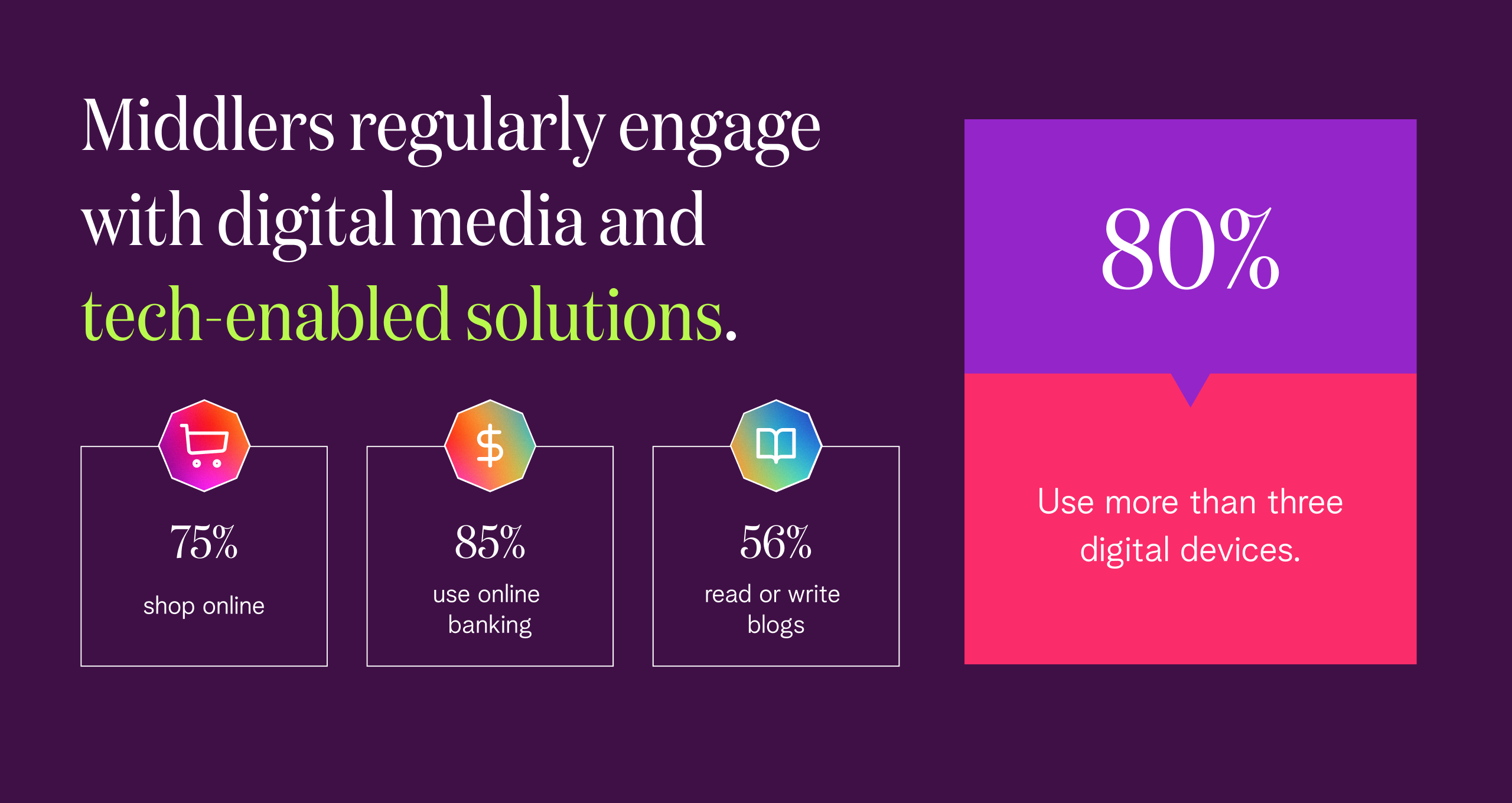
Health is also on the mind of many in this age range – nearly 100% of older adults listed staying healthy as a primary focus. Taking care of and investing in oneself clearly entails paying close attention to day-to-day wellbeing. However, their healthcare must work with their lifestyles: after years of living “scheduled” lives, older adults are grateful for the ownership that they now have over their own schedules, and therefore many prefer to keep their schedules flexible. A sense of independence and autonomy within the healthcare ecosystem is also critically important – 97% of respondents agreed with this statement: “I want to be the one who makes decisions about getting the help and care I need” and 43% stated they valued independence.
Middlers need healthcare services that capitalize on their autonomous, active lifestyles. With the value they place on independence and mental engagement (78% indicated that they enjoy learning new things), combined with their capacity for digital engagement, a digital health ecosystem provides a flexible way for Middlers to engage with their health on their own time and on their own terms. By allowing them to seamlessly integrate healthcare-related activities that positively impact their mental and physical wellbeing into their “me time,” tech-enabled solutions might aid Middlers in warding off subpar health outcomes into their 80s and beyond.
For Middlers, technology shouldn’t be viewed as a barrier, but rather as a tool to improve healthcare.
It’s not tech-enabled solutions that Middlers take issue with, since many use them every day; it's the barriers to entry that make these solutions challenging to adopt. There are accessibility issues, high expenses, and substantial learning curves associated with using new technology solutions. On the other hand, digital solutions that are easy to use, affordable, and include tutorials (virtual or in-person), can enable Middlers’ independent, tech-enabled way of living while at the same time providing access to care-at-home.
Middlers are actually quite comfortable using technology in everyday life. In fact, 75% regularly shop online, 85% do their banking online, and 30% order food or groceries for pick up or delivery at least several times a month. Alongside its utility status, the internet is yet another avenue for the intellectual fulfillment that Middlers constantly seek: 56% write or read blogs, reviews, ratings, or comments online.
Middlers don’t just enjoy their favorite activities in an online format—many of them are actively interested in using technologically-enabled solutions, where 78% say that they “enjoy learning new things or technologies.” While they might not self-identify as tech-savvy, technology is firmly embedded in their lives: 80% of survey respondents use more than three digital devices (i.e., smartphones, e-readers, Amazon Echo, etc.) on a daily or weekly basis.
One survey respondent shared:
“I am at age 65, and as a younger senior, things are easier for me regarding technology than the later generations. I have used technology for many, many years. I am comfortable with it.”
But that doesn’t mean there aren’t still a few barriers holding older adults back from utilizing new tech-enabled solutions. Only 18% prefer learning about new technology virtually or online. When asked what companies could do to help them use new technologies, responses could fall into the following themes:
Ease of use:“Just make things easy to read, understand, and follow.”
Video/Virtual Help: “Conduct 1-on-1 virtual sessions with each person instead of in a virtual classroom.”
Lower Cost:“Make it more affordable.”
With 33% of respondents already having used virtual healthcare or telehealth services, many older adults could benefit from the simultaneous engagement in online communities and mental stimulation offered by digital health solutions.
Community, digital or otherwise, is key for Middlers.
Older adults are looking for ways to meet new people, sustain previous friendships, and feel connected to their communities. A recent study proves that community is a crucial social determinant of health, revealing that a lower sense of community belonging is associated with poorer general and mental health. Solution-builders should increasingly look to deliver a hybrid care experience that can fulfill both older adults’ desire to feel a sense of community and act as independent facilitators of their health.
While Middlers lovingly refer to this period in life as “the age of me,” that doesn’t mean they plan to experience it alone. A significant component of “staying busy” for this group is social connection. Across our research, 67% of respondents agreed that “feeling a sense of belonging and like you’re part of a community” is important and 76% said it’s “important for them to find new ways to engage with existing family/friends/community.”
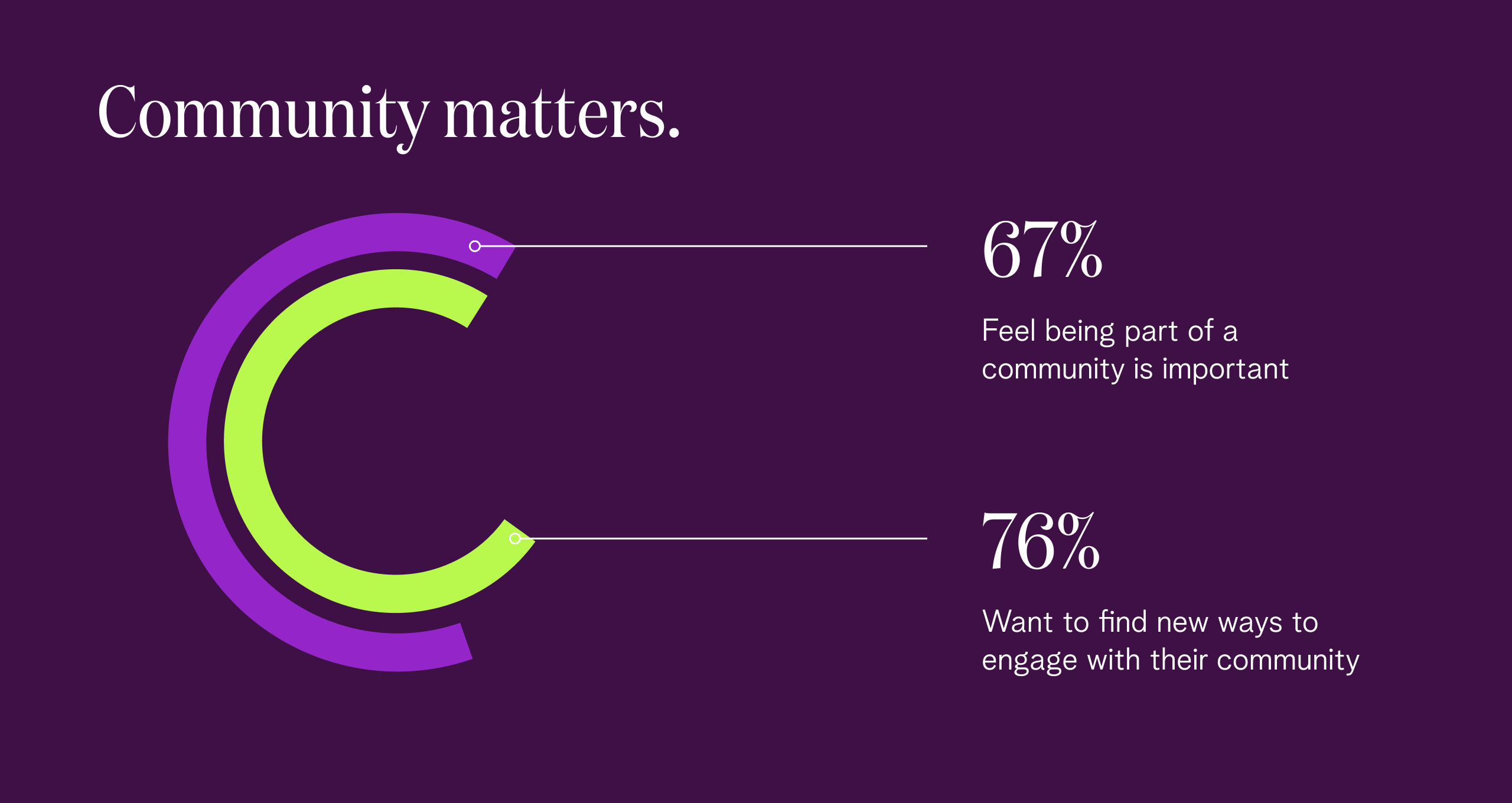
One way Middlers socialize is through social media: 80% use social network sites such as Facebook, Twitter, or Instagram. 51% of respondents indicated that they use these sites daily. While on social media, older adults aren’t just browsing the content or following other people’s posts—they’re actively engaged. 43% comment on others’ posts, and 30% share their lives on social media with friends and family.
Additionally, Middlers associate their community (and technology) with greater learning opportunities. Middlers routinely look to their peers to discover new interests and are excited to learn by reading their peers’ comments and questions online. They appreciate being able to see the number of members who have taken a class, joined a forum page, or rated an instructor 10/10. 36% of individuals responded that learning from friends or family is the most preferred way of learning. One finding that’s in line with Middlers' embrace of an independent attitude, but may come as a surprise given the common perception that older people always need in-person assistance when learning new technologies: our research revealed that Middler’s second most preferred way of learning (25%) is figuring things out by themselves.
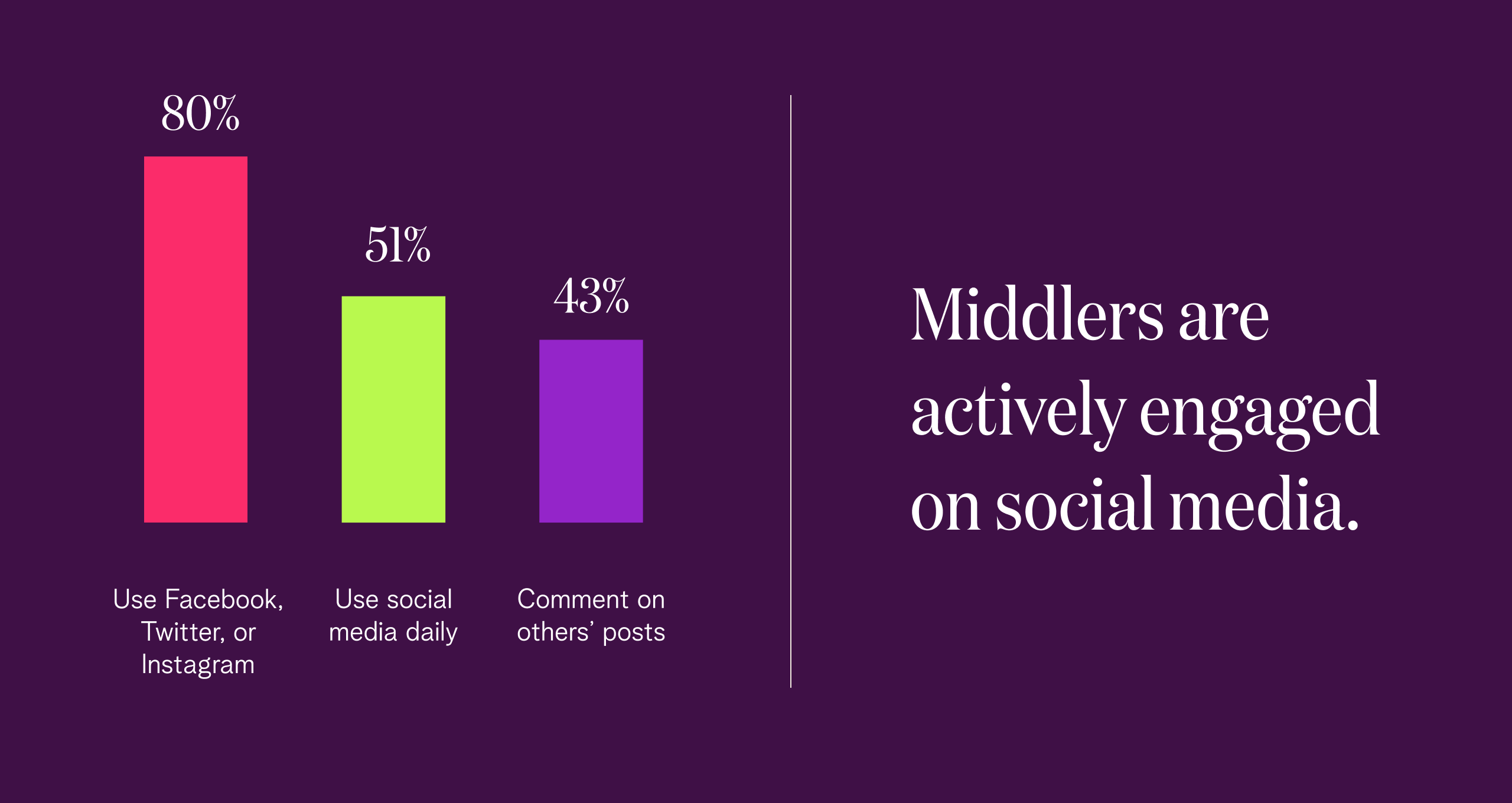
With a strong appetite for community bonding and learning, Middlers would benefit from healthcare solutions that take a hybrid approach to care delivery. An ideal approach is one that combines technology, the mobile and in-home capabilities of which are suited for Middlers’ preference for flexible scheduling, with the human touch and discretion of in-person care providers who can empathetically and effectively address their health concerns and needs.
In designing healthcare solutions for this population, it’s important for innovators to meet them where they are — and while they regularly use technology to connect with friends and loved ones, they still prefer to learn in person. By combining the ease of a digital app with the socialization of in-person care providers or group treatments, innovators can ensure Middlers are able to maintain both their independence and desire for a supportive community.
Health-tech can promote healthier aging by meeting Middlers where they’re at and designing solutions that address their needs and interests.
A notable 41% of older adults disagree with the statement “My best days are behind me.”
Overwhelmingly, we found that Middlers desire to remain independent while engaging with community, technology, and life-fulfilling learning opportunities. They have the desire and capability to integrate healthcare into their lives while they’re making the most out of them. Health solutions’ designs should reflect that reality.
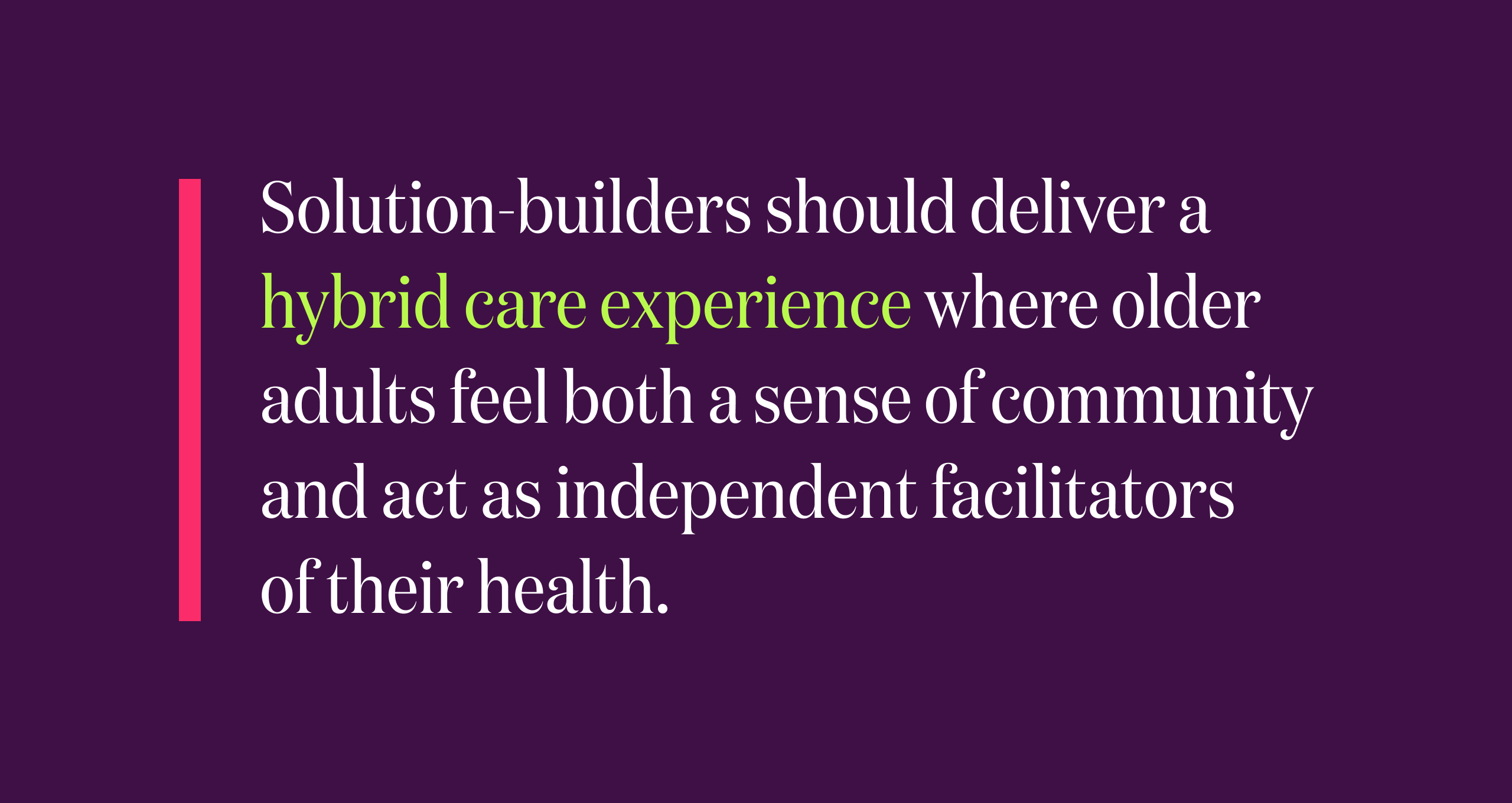
There’s an urgent need to tailor more of our healthcare solutions for use by Middlers in order to increase the adoption of impactful solutions now. In doing so, it’s equally important that we recognize the role improving access to these solutions, and life-changing technology at large, will play in redesigning health amongst the Middler population. Early intervention can result in lasting benefits that positively impact so many different stakeholders within the healthcare ecosystem, including caregivers and family members.
For inspiration, three Operating Companies —all built at Redesign Health — present a digitally-inclusive path toward better health outcomes for older adults:
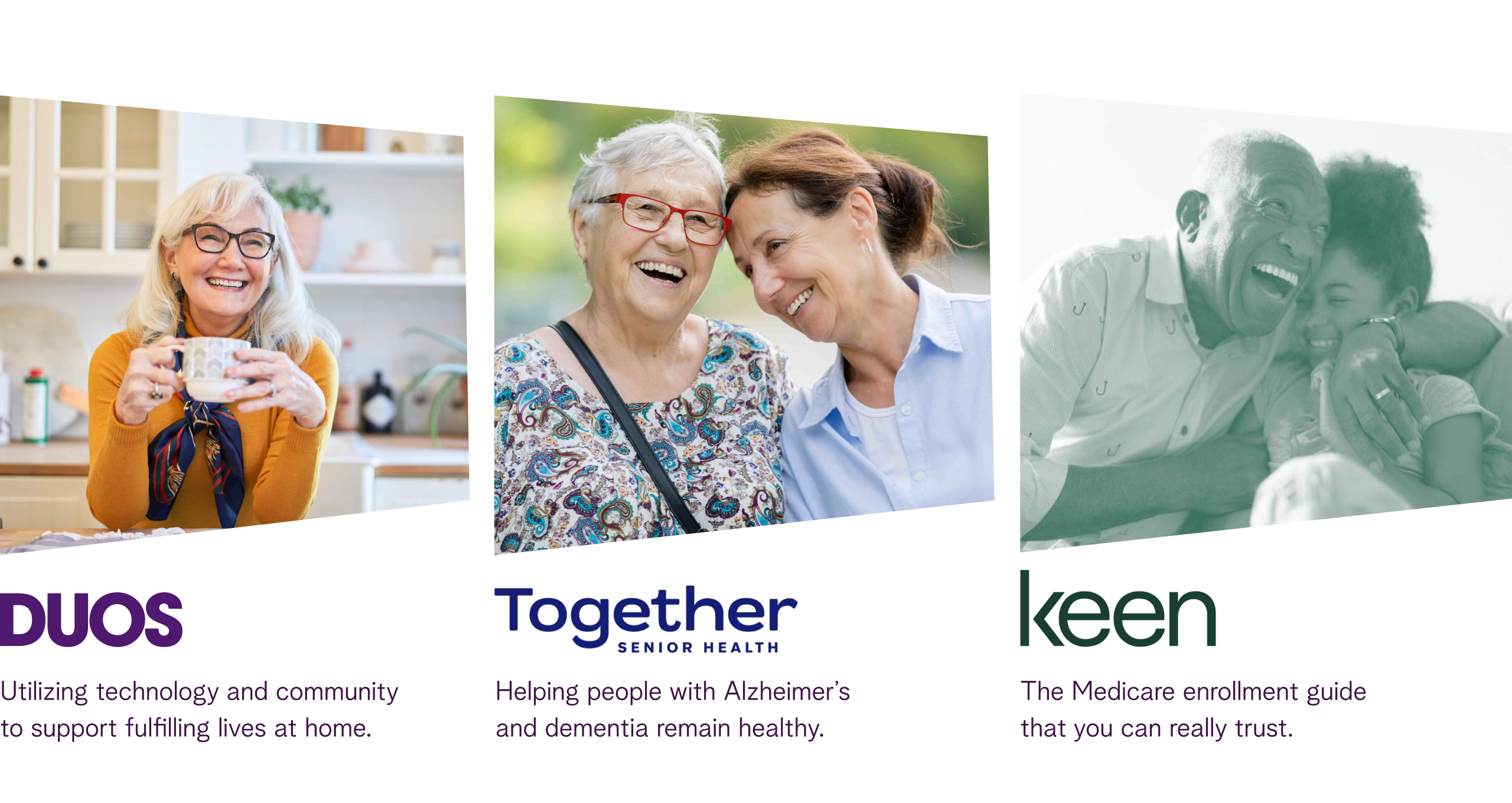
DUOS is a personal assistant service (available at no cost through health insurance) that helps older adults age independently and helps promote better health outcomes, while Keen is also a no cost service created for Medicare-eligible consumers that helps make enrollment as simple as possible. Finally, Together Senior Health combines clinical evidence, user experience and engaging, community-based programming in order to help people with Alzheimer’s and dementia remain healthy and independent at home.
The data included in this whitepaper is from internal research conducted across 17 qualitative and quantitative studies with older adults spanning the ages of 55-79 years old.
![No alternate text]() Redesign HealthDemystifying Healthcare Innovation: 4 Lessons on Driving Meaningful Change
Redesign HealthDemystifying Healthcare Innovation: 4 Lessons on Driving Meaningful ChangeInnovation is a frequently used buzzword in healthcare. Despite its widespread usage within our industry, achieving tangible value and impactful outcomes often proves challenging.
April 16, 2024
![No alternate text]() Healthcare TrendsRedesign Health2024 Health Trends: 4 Experts Discuss Key Innovation Priorities
Healthcare TrendsRedesign Health2024 Health Trends: 4 Experts Discuss Key Innovation PrioritiesTo uncover the most pressing healthcare issues—and possible solutions—on the horizon for 2024, our team polled four influential industry thought leaders and Executive Advisory Board members at Redesign Health.
January 10, 2024
![No alternate text]() MedicaidModernizing Medicaid with a Multi-Stakeholder Financing Model
MedicaidModernizing Medicaid with a Multi-Stakeholder Financing ModelDiscover how a multi-stakeholder financing model could overcome some of Medicaid’s obstacles, dramatically improving health and quality of life outcomes for Medicaid recipients while generating savings across government programs.
November 15, 2023
![No alternate text]() Chronic CareRedesign HealthWraparound Care: The Next Frontier in Chronic Care Management
Chronic CareRedesign HealthWraparound Care: The Next Frontier in Chronic Care ManagementExploring tech-infused strategies to manage chronic conditions
September 05, 2023
![No alternate text]() ADVISORSRedesign HealthRedesign Health Advise: Leveraging Experts and Insights to Expand Impact
ADVISORSRedesign HealthRedesign Health Advise: Leveraging Experts and Insights to Expand ImpactThe Redesign Health Advise program connects our team and founders with a deep bench of experts from across the healthcare industry.
June 29, 2023
![No alternate text]() Senior HealthRedesign HealthInvesting in AgeTech: Serving the Growing Senior Health Market
Senior HealthRedesign HealthInvesting in AgeTech: Serving the Growing Senior Health MarketProviding targeted tech solutions for aging adults
June 14, 2023
![No alternate text]() Shifting Sites of Patient Care: Driving Value in Alternative Settings
Shifting Sites of Patient Care: Driving Value in Alternative SettingsRight care, right setting: Unlocking value in alternative sites of care
April 27, 2023
![No alternate text]() Value-Based CareThe Evolution of Value-Based Care: Exploring Challenges and Opportunities in Adoption
Value-Based CareThe Evolution of Value-Based Care: Exploring Challenges and Opportunities in AdoptionRedesign Health Venture Chair Missy Krasner recently hosted a roundtable discussion with leaders in the Value-Based Care Industry to explore how the adoption of value-based care is unfolding--and what to expect in the coming years.
February 15, 2023
![No alternate text]() James QuarlesThe Kids Aren’t Alright: Addressing the Adolescent Mental Health Crisis With Accessible, High Quality, Evidence-Based Practice
James QuarlesThe Kids Aren’t Alright: Addressing the Adolescent Mental Health Crisis With Accessible, High Quality, Evidence-Based PracticeResearch shows that mental health disorders have surpassed physical conditions as the most common causes of impairments and limitations in children. Suicide was the second-leading cause of death among 10 to 14 year-olds in 2020.
February 15, 2023
![No alternate text]() PartnershipsRedesign HealthPartnering with Leading Health Systems to Drive Change and Improve Outcomes
PartnershipsRedesign HealthPartnering with Leading Health Systems to Drive Change and Improve OutcomesAt Redesign Health, we firmly believe the US healthcare system desperately needs innovation to address our lagging health outcomes, sky-high costs and uneven access to care.
February 09, 2023
![No alternate text]() Platform, Company CreationBehind the Curtain: Redesign Health's Company Creation Process
Platform, Company CreationBehind the Curtain: Redesign Health's Company Creation ProcessIt's easy to say healthcare is broken. It's much harder to fix it. At Redesign Health, we’re up for the challenge.
February 01, 2023
![No alternate text]() Healthcare TrendsHealthcare’s Biggest Trends in 2023: Industry Forecast from Redesign Health
Healthcare TrendsHealthcare’s Biggest Trends in 2023: Industry Forecast from Redesign HealthPowering healthcare innovation at scale is the heart of our work at Redesign Health. With 2023 on the horizon, we surveyed our cross-functional team of industry leaders for their forecast for 2023’s biggest trends in healthcare.
December 15, 2022
![No alternate text]() Insights from the Redesign Health Ecosystem: Improving Healthcare for Older Adults
Insights from the Redesign Health Ecosystem: Improving Healthcare for Older AdultsRedesign Health Venture Chair Missy Krasner recently hosted a roundtable discussion with leaders from three of our Operating Companies to explore the state of older adult healthcare in the U.S. and how their teams are facilitating healthier aging.
October 21, 2022
![No alternate text]() ResearchRedesign HealthStuck in the Middle: Healthcare Solutions for Older Adults Shouldn’t Be One Size Fits All. Here's Why.
ResearchRedesign HealthStuck in the Middle: Healthcare Solutions for Older Adults Shouldn’t Be One Size Fits All. Here's Why.There will be more older adults than children in America by 2035. We are not ready. A one-size-fits-all approach to older adult healthcare simply won’t be able to comprehensively support the needs of so many aging people.
October 05, 2022
![No alternate text]() Company CultureRedesigning Company Culture
Company CultureRedesigning Company CultureWe have big ambitions at Redesign Health: to make humanity healthier and to redesign healthcare for everyone. We strive to do things differently here, and building our company culture is no exception.
July 18, 2022





